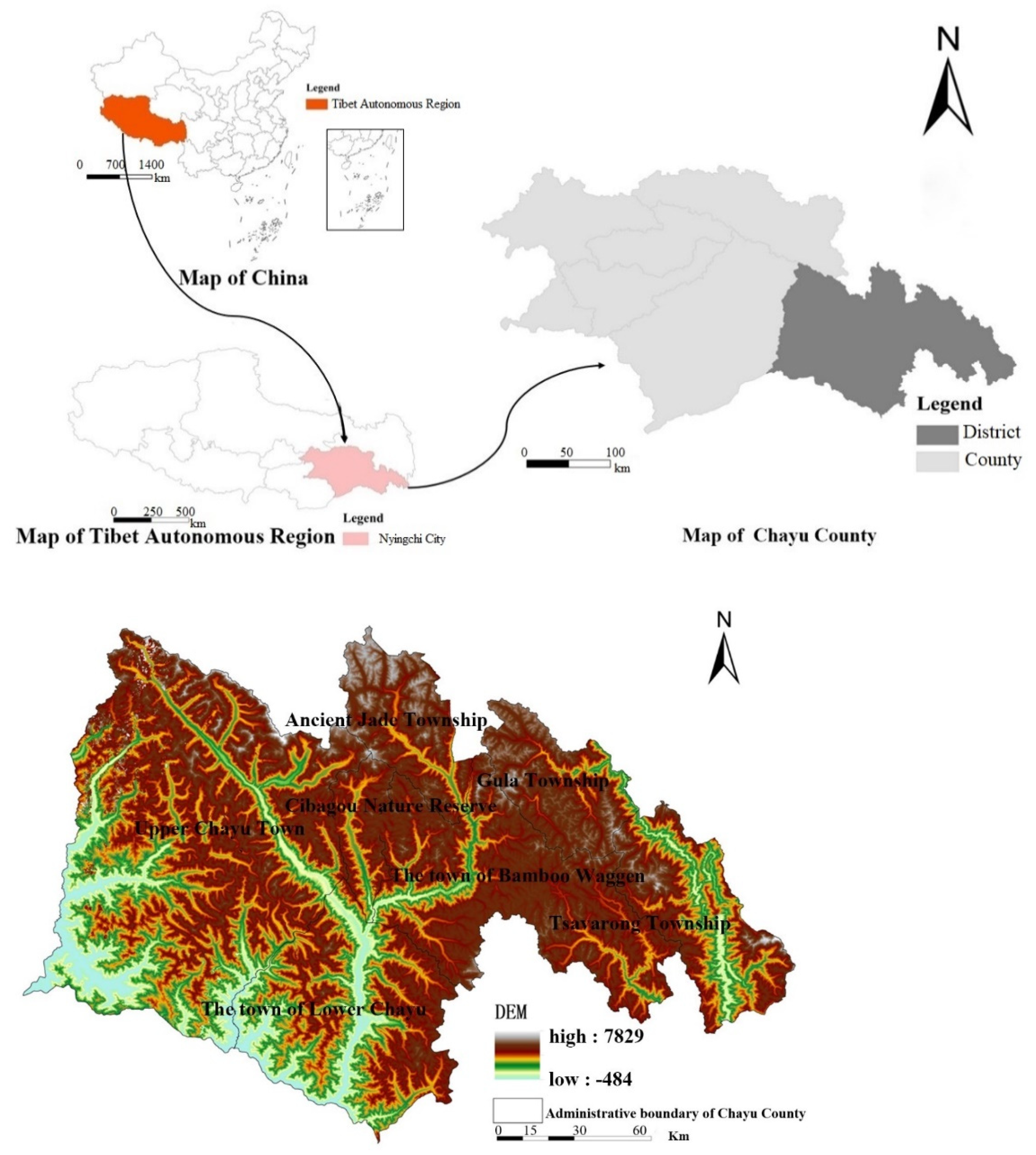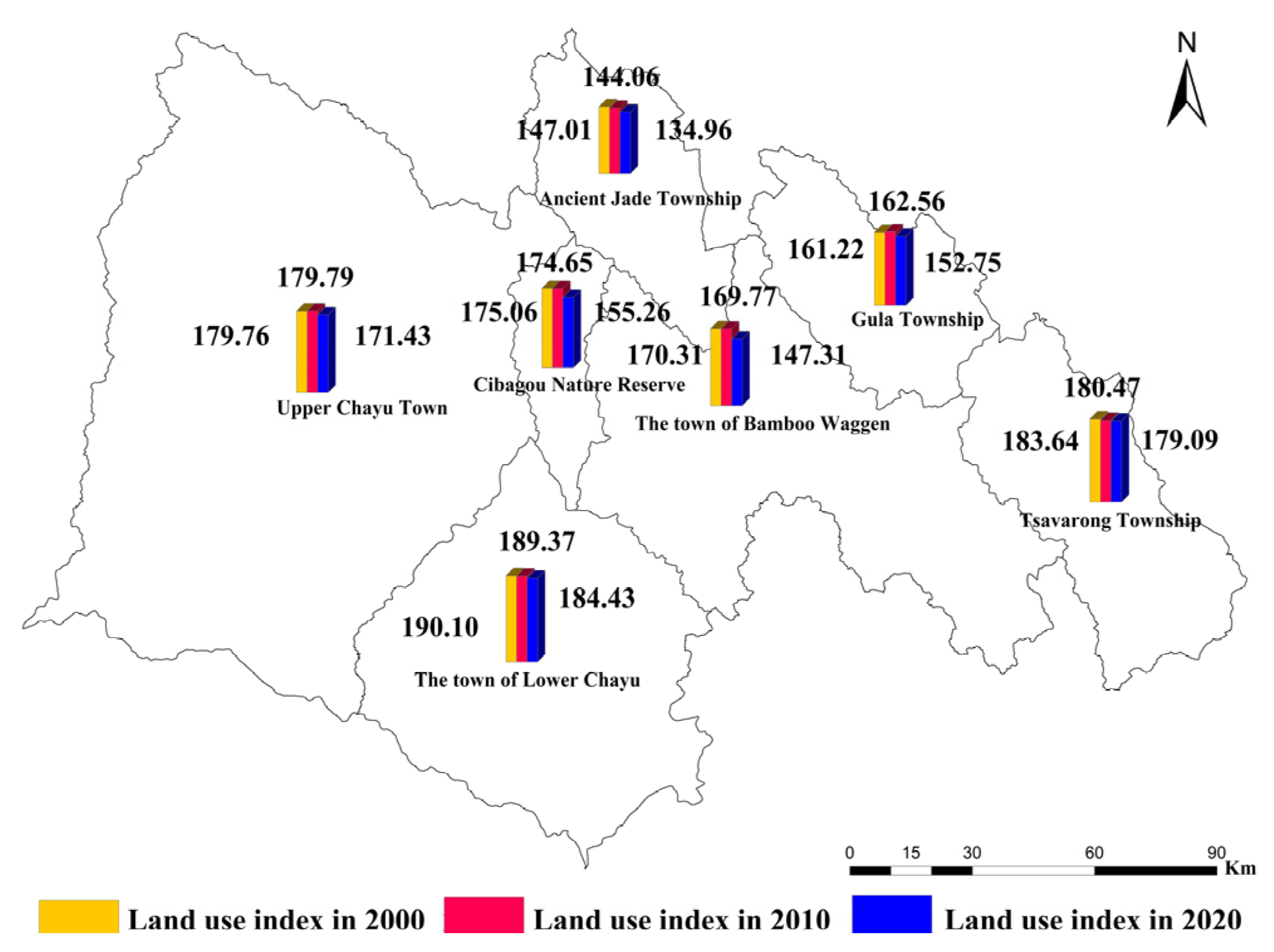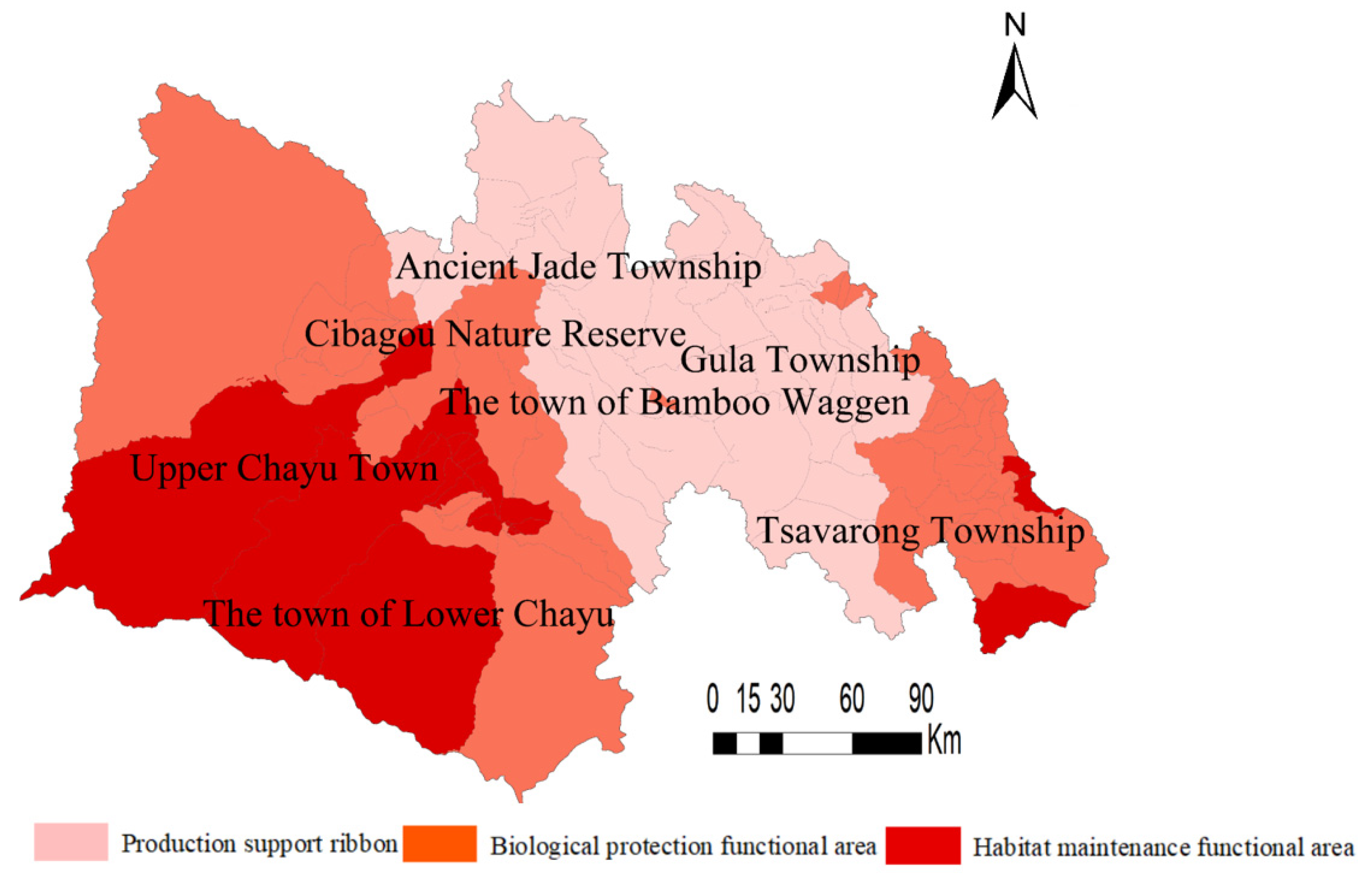Study on the Spatial-Temporal Evolution of Land Use Ecosystem Service Value and Its Zoning Management and Control in the Typical Alpine Valley Area of Southeast Tibet—Empirical Analysis Based on Panel Data of 97 Villages in Chayu County
Abstract
:1. Introduction
2. Overview of the Study Area
3. Data Sources and Research Methodology
3.1. Sources of Data
3.2. Research Methodology
3.2.1. Land Use Change
- (1)
- Model of land use quantity change
- (2)
- Land use degree change model
3.2.2. Ecosystem Service Value Assessment
- (1)
- Value revision assessment
- (2)
- Value dynamics
- (3)
- Sensitivity index
3.2.3. Spatial Agglomeration of Ecosystem Service Value
- (1)
- Kernel density analysis
- (2)
- Spatial autocorrelation analysis
4. Results and Analysis
4.1. Analysis of Land Use Change
4.1.1. Characteristics of Changes in Land Use Quantity
4.1.2. Characteristics of Land Use Change
4.2. Value Analysis of Ecosystem Services
4.2.1. Temporal Change Analysis of Ecosystem Services
4.2.2. Spatial Change Analysis of the Value of Ecosystem Services
4.2.3. Analysis of Dynamic Change Degree of Ecosystem Service Value
4.2.4. Sensitivity Analysis of Ecosystem Service Value
4.3. Spatial Agglomeration Analysis of Ecosystem Service Value
4.3.1. Kernel Density Analysis
4.3.2. Spatial Autocorrelation Analysis
4.4. Optimization of the Pattern of Ecological Functions of Land Use
4.4.1. Habitat Maintenance Functional Area
4.4.2. Biological Protection Functional Area
4.4.3. Production Support Functional Area
5. Discussion and Conclusions
5.1. Discussion
5.2. Conclusions
Author Contributions
Funding
Institutional Review Board Statement
Informed Consent Statement
Data Availability Statement
Conflicts of Interest
References
- Skole, D.L.B., II; Sanderson, S.; Fischer, G.; Leemans, R. Land use and land cover change. Earth Sci. Front. 1997, 4, 26–33. [Google Scholar]
- Costanza, R.; D’Arge, R.; Groot, R.D.; Farber, S.; Grasso, M.; Hannon, B.; Limburg, K.; Naeem, S.; O’Neill, R.V.; Paruelo, J.; et al. The value of the world’s ecosystem services and natural capital. Nature 1997, 387, 253–260. [Google Scholar] [CrossRef]
- Daily, G.C.; Soederqvist, T.; Aniyar, S.; Arrow, K.; Dasgupta, P.; Ehrlich, P.R.; Folke, C.; Jansson, A.; Jansson, B.O.; Kautsky, N.; et al. The value of nature and the nature of value. Science 2000, 289, 395–396. [Google Scholar] [CrossRef] [PubMed]
- Etienne, C.; Jessica, P.; Yoann, L.G.; Mathieu, F. Spatial patterns of vineyard abandonment and related land use transitions in Beaujolais (France): A multiscale approach. Sustainability 2020, 12, 4695. [Google Scholar]
- Schneider, A.; Kucharik, L.C.J.; Christopher, J.K. Impacts of urbanization on ecosystem goods and services in the U.S. Corn Belt. Ecosystems 2012, 15, 519–541. [Google Scholar] [CrossRef]
- Huang, M.Y.; Yue, W.Z.; Fang, B.; Feng, S.R. Scale response characteristics and geographic exploration mechanism of spatial differentiation of ecosystem service values in Dabie mountain area. central China from 1970 to 2015. Acta Geogr. Sin. 2019, 74, 1904–1920. [Google Scholar]
- Daily, G.C. Natures Service: Social Dependence on Nature Ecosystems; Island Press: Washington, DC, USA, 1997. [Google Scholar]
- Robert, C.; Ralph, D.; Rudolf, G. The value of the world’s ecosystem services and natural capital. Nat. Int. Wkly. J. Sci. 1997, 387, 253–260. [Google Scholar]
- Liu, F.L.; Yang, R.Y. Evolution of land use patterns in national central cities and its impact on ecosystem service values: A case study of Wuhan city. Res. Soil Water Conserv. 2021, 28, 177–183+193+2. [Google Scholar]
- Xie, G.D.; Zhang, C.X.; Zhang, L.M.; Chen, W.H.; Li, S.M. Improvement of the evaluation method for ecosystem service value based on per unit area. J. Nat. Resour. 2015, 30, 1243–1254. [Google Scholar]
- Xie, G.D.; Zhen, L.; Lu, C.X.; Xiao, Y.; Chen, C. Expert knowledge-based valuation method of ecosystem services in China. J. Nat. Resour. 2008, 23, 911–919. [Google Scholar]
- Xie, G.D.; Zhang, C.X.; Zhang, C.S.; Xiao, Y.; Lu, C.X. The value of ecosystem services in China. Resour. Sci. 2015, 37, 1740–1746. [Google Scholar]
- Sun, H.L.; Chen, Y.N.; Li, W.H.; Li, F.; Mubarek, A. Study on types and ecological services values of the grassland in the ili river Basin. Xinjiang. China. J. Desert Res. 2011, 31, 1273–1277. [Google Scholar]
- Luo, N.N.; Mao, D.H.; Wen, B.L.; Liu, X.T. Climate change affected vegetation dynamics in the Northern Xinjiang of China: Evaluation by SPEI and NDVI. Land 2020, 9, 90. [Google Scholar] [CrossRef]
- Xia, J.Y.; Cao, M.; Xiao, W.; Li, Y.P.; Fu, G.; Wang, W.; Li, J.S. Integrating spatial valuation of ecosystem services into protected area management: A case study of the Cangshan Nature Reserve Dali, China. Sustainability 2020, 12, 9395. [Google Scholar] [CrossRef]
- Liu, M.Z.; Jia, Y.G.; Zhao, J.J.; Shen, Y.J.; Pei, H.W.; Zhang, H.J.; Li, Y.L. Revegetation projects significantly improved ecosystem service values in the agropastoral ecotone of northern China in recent 20 years. Sci. Total Environ. 2021, 788, 147756. [Google Scholar] [CrossRef]
- Tong, S.Q.; Bao, G.; Rong, A.H.; Huang, X.J.; Bao, Y.B.; Bao, Y.H. Comparison of the spatiotemporal dynamics of land use changes in four municipalities of China based on intensity analysis. Sustainability 2020, 12, 3687. [Google Scholar] [CrossRef]
- Chen, J.Y.; Luo, H.X.; Hu, L.L.; Li, Q.H.; Jiang, W.J. Correlation between social economic development and ecosystem service value: A case of Chongqing metropolitan area. Res. Soil Water Conserv. 2017, 24, 330–336. [Google Scholar]
- Yu, L.L.; Zhang, X.X.; Li, Y.F.; Zhao, X.X.; Ma, S.Q.; Cao, H.H.; Cao, J.K. Coastal ecosystem services and their spatial-temporal variation in Haikou. China. Acta Ecol. Sin. 2016, 36, 2431–2441. [Google Scholar]
- Fu, J.; Liu, Y.; Lü, Y. Assessing the soil erosion control service of ecosystems change in the Loess Plateau of China. Ecol. Complex. 2011, 8, 284–293. [Google Scholar] [CrossRef]
- Geng, Q.L.; Ren, Q.F.; Yan, H.M. Target areas for harmonizing the Grain for Green Programmed in China’s Loess Plateau. Land Degrad. Dev. 2019, 31, 325–333. [Google Scholar] [CrossRef]
- Costanza, R.; De Groot, R.; Sutton, P.; van der Ploeg, S.; Anderson Sharolyn, J.; Kubiszewski, I.; Farber, S.; Turner, R. Changes in the global value of ecosystem services. Glob. Environ. Chang. 2014, 26, 152–158. [Google Scholar] [CrossRef]
- Wang, Z.Y.; Cao, J.S. Assessing and predicting the impact of multi-scenario land use changes on the ecosystem service value: A case study in the upstream of Xiong’ an New Area, China. Sustainability 2021, 13, 704. [Google Scholar] [CrossRef]
- BAI, E.; Bing, X. A review of influences of land use and land cover change on ecosystems. Chin. J. Plant Ecol. 2020, 44, 543–552. [Google Scholar] [CrossRef]
- Li, H.; Zhang, X.Y.; Guo, H.L. Spatial and temporal changes of ecosystem service value in the three gorges reservoir area in the past 30 yeas based on land use. Res. Soil Water Conserv. 2021, 28, 309–318. [Google Scholar]
- Liu, J.Y.; Zhuang, D.F.; Zhang, Z.X.; Gao, Z.Q.; Deng, X.Z. The establishment of land use spatial temporal database and its relative studies in China. J. Geo-Inf. Sci. 2002, 4, 3–7+4. [Google Scholar]
- Daniela, S.; Michelangelo, C.; Annalisa, A.; Donato, M.; Sašo, D. Dealing with spatial autocorrelation when learning predictive clustering trees. Ecol. Inform. 2013, 13, 22–39. [Google Scholar]
- Myong, G.C.; Junko, N. Geographic spatial autocorrelation of morphological characters of the Hemerocallis middendorffii complex (Liliaceae). Ann. Bot. Fenn. 1998, 35, 183–189. [Google Scholar]
- Ma, Y.J.; Huang, X.J.; Xu, M.M.; Zhong, T.Y.; Du, W.X. Sensitivity analysis of ecosystem service value to coastal tideland development in Jiangsu Province. China Land Sci. 2006, 4, 28–34. [Google Scholar]
- Hu, Y.; Qiao, W.F.; He, T.Q. Changes of the land use pattern and ecosystem service value in Yangtze—hwai ecological economic zone. Resour. Environ. Yangtze Basin 2020, 29, 2450–2461. [Google Scholar]
- Sun, B.C.; Ding, Z.L.; Wang, D.Q.; Wang, H.Y. Ecological functional zone of land use of Shuangyashan based on ARCGIS method. J. Northeast. Agric. Univ. 2011, 42, 109–113. [Google Scholar]
- Sun, H.L.; Zheng, D.; Yao, T.D. Protection and construction of the national ecological security shelter zone on Tibetan Plateau. Acta Geogr. Sin. 2012, 67, 3–12. [Google Scholar]
- Alipbeki, O.; Alipbekova, C.; Sterenharz, A.; Toleubekova, Z.; Aliyev, M.; Mineyev, N.; Amangaliyev, K. A spatiotemporal assessment of land use and land cover changes in Peri-Urban areas: A case study of arshaly district, Kazakhstan. Sustainability 2020, 12, 1556. [Google Scholar] [CrossRef]
- Xia, S.F.; Chen, M.Q.; Liu, X.; Cai, H.S. Land resources ecosystem service value accounting of Ganzhou city based on geographic national condition information. Trans. Chin. Soc. Agric. Mach. 2019, 50, 184–193. [Google Scholar]
- Gao, H.J.; Han, H.Q.; Luo, X.Q.; Yu, H.Y.; Han, M.R. Spatial correlation of socioeconomic factors and ecosystem service values n Guizhou province. Res. Soil Water Conserv. 2016, 23, 262–266. [Google Scholar]
- Li, J.C.; Wang, W.L.; Hu, G.Y.; Wei, Z.H. Impacts of land use and cover changes on ecosystem service value in Zoige Plateau. Acta Ecologica Sinica 2011, 31, 3451–3459. [Google Scholar]
- Li, S.; He, F.; Zhang, X.; Zhou, T. Evaluation of global historical land use scenarios based on regional datasets on the Qinghai–Tibet Area. Sci. Total Environ. 2019, 657, 1615–1628. [Google Scholar] [CrossRef]
- Wang, L.Y.; Ke, X.L.; Hatab, A.A. Trade-Offs between Economic Benefits and Ecosystem Services Value under Three Cropland Protection Scenarios for Wuhan City in China. Land 2020, 9, 117. [Google Scholar] [CrossRef]
- Li, T.H.; Li, W.K.; Qian, Z.H. Variations in ecosystem service value in response to land use changes in Shenzhen. Ecol. Econ. 2008, 69, 1427–1435. [Google Scholar]
- Wei, X.D.; Wang, N.; Luo, P.P.; Yang, J.; Zhang, J.; Lin, K.L. Spatiotemporal assessment of land marketization and its driving forces for sustainable urban–rural development in Shaanxi Province in China. Sustainability 2021, 13, 7755. [Google Scholar] [CrossRef]
- Zulpiya, M.M.T.; Hamit, Y.M.T.; Anwar, E.Z.I.Z.; Ajigul, A.B.L.M.T. Response of ecosystem services value to land use/cover change in the Yanqi Basin of Xinjiang, China. J. Desert Res. 2014, 34, 275–283. [Google Scholar]








| Ecosystem Services and Functions | Cultivated Land | Woodland | Grassland | Wetland | Waters | Unused Land |
|---|---|---|---|---|---|---|
| gas exchange | 111.45 | 780.18 | 178.33 | 401.23 | 0.00 | 0.00 |
| Climate regulation | 198.39 | 601.85 | 200.62 | 3811.72 | 102.54 | 0.00 |
| water conservation | 133.74 | 713.30 | 178.33 | 3455.07 | 4542.85 | 6.69 |
| Soil formation and protection | 325.44 | 869.34 | 434.67 | 381.17 | 2.23 | 4.46 |
| waste disposal | 365.57 | 292.01 | 292.01 | 4052.46 | 4052.46 | 4.46 |
| Biodiversity conservation | 158.26 | 726.68 | 242.97 | 557.27 | 555.04 | 75.79 |
| Food production | 222.91 | 22.29 | 66.87 | 66.87 | 22.29 | 2.23 |
| raw material | 22.29 | 579.56 | 11.15 | 15.60 | 2.23 | 0.00 |
| Entertainment and leisure | 2.23 | 285.32 | 8.92 | 1237.14 | 967.42 | 2.23 |
| Land Use Type | 2000 | 2010 | 2020 |
|---|---|---|---|
| Cultivated land | 0.27 | 0.14 | 0.19 |
| woodland | 54.56 | 53.55 | 50.04 |
| grassland | 21.04 | 21.76 | 14.88 |
| Wetland | 0.02 | 0.01 | 0.02 |
| waters | 0.44 | 0.37 | 0.42 |
| land used for building | 0.01 | 0.01 | 0.03 |
| Unused land | 23.66 | 24.16 | 34.42 |
| 2020 | Grassland | Cultivated Land | Land Used for Building | Woodland | Wetland | Waters | Unused Land | |
|---|---|---|---|---|---|---|---|---|
| 2000 | ||||||||
| grassland | 3629.95 | 3.81 | 1.56 | 660.35 | 0.29 | 5.64 | 2306.43 | |
| Cultivated land | 35.35 | 31.15 | 3.45 | 14.08 | 0.01 | 0.40 | 0.97 | |
| land used for building | 0.19 | 0.75 | 1.68 | 0.10 | 0.00 | 0.02 | 0.03 | |
| woodland | 824.58 | 25.13 | 2.21 | 14,944.67 | 0.55 | 33.83 | 1304.94 | |
| Wetland | 0.77 | 0.03 | 0.02 | 0.61 | 2.27 | 0.72 | 1.79 | |
| waters | 7.09 | 0.12 | 0.04 | 13.64 | 1.14 | 81.96 | 32.98 | |
| Unused land | 174.48 | 0.13 | 0.12 | 83.56 | 2.41 | 9.18 | 7162.68 | |
| Land Use Type | Cultivated Land | Woodland | Grassland | Wetland | Waters | Unused Land | |
|---|---|---|---|---|---|---|---|
| 2000 | Area (km2) | 85.41 | 17,135.91 | 6608.03 | 6.21 | 136.97 | 7432.56 |
| ESV (RMB 100 million) | 13.16 | 8346.09 | 1066.44 | 8.68 | 140.35 | 71.24 | |
| 2010 | Area (km2) | 45.24 | 16,818.29 | 6833.31 | 3.54 | 114.81 | 7589.31 |
| ESV (RMB 100 million) | 6.97 | 8191.40 | 1102.79 | 4.95 | 117.65 | 72.74 | |
| 2020 | Area (km2) | 61.12 | 15,717.01 | 4672.41 | 6.67 | 131.75 | 10,809.82 |
| ESV (RMB 100 million) | 9.41 | 7655.02 | 754.06 | 9.32 | 135.00 | 103.61 | |
| 2000–2010 | ESV change value | −6.19 | −154.70 | 36.36 | −3.73 | −22.71 | 1.50 |
| ESV change rate | −47.03% | −1.85% | 3.41% | −43.00% | −16.18% | 2.11% | |
| Area change value | −40.17 | −317.62 | 225.28 | −2.67 | −22.16 | 156.75 | |
| Area change rate | −47.03% | −1.85% | 3.41% | −43.00% | −16.18% | 2.11% | |
| 2010–2020 | ESV change value | 2.45 | −536.38 | −348.74 | 4.38 | 17.36 | 30.87 |
| ESV change rate | 35.10% | −6.55% | −31.62% | 88.42% | 14.75% | 42.43% | |
| Area change value | 15.88 | −1101.28 | −2160.90 | 3.13 | 16.94 | 3220.51 | |
| Area change rate | 35.10% | −6.55% | −31.62% | 88.42% | 14.75% | 42.43% | |
| 2000–2020 | ESV change value | −3.74 | −691.08 | −312.38 | 0.64 | −5.35 | 32.37 |
| ESV change rate | −28.44% | −8.28% | −29.29% | 7.41% | −3.81% | 45.44% | |
| Area change value | −24.29 | −1418.90 | −1935.62 | 0.46 | −5.22 | 3377.26 | |
| Area change rate | −28.44% | −8.28% | −29.29% | 7.41% | −3.81% | 45.44% | |
| (Township) Town Name | Cultivated Land | Woodland | Grassland | Wetland | Waters | Unused Land |
|---|---|---|---|---|---|---|
| Entire | −1.42 | −0.41 | −1.46 | 0.37 | −0.19 | 2.27 |
| Upper Chayu Town | −0.41 | −0.34 | −1.53 | 4.76 | 0.80 | 2.05 |
| The town of Lower Chayu | −1.86 | −0.15 | −0.85 | −2.32 | −1.07 | 2.35 |
| The town of Bamboo Waggen | 0.00 | −0.79 | −2.47 | 1.21 | −3.39 | 3.88 |
| Tsavarong Township | 0.00 | −0.38 | −0.12 | 1.43 | 1.16 | 1.41 |
| Ancient Jade Township | 0.64 | −1.29 | −1.30 | −5.00 | 1.37 | 1.14 |
| Gula Township | 0.00 | −0.77 | −0.64 | 0.00 | −2.56 | 1.10 |
| Cibagou Nature Reserve | 0.00 | −0.83 | −3.03 | 0.00 | −4.02 | 3.97 |
Publisher’s Note: MDPI stays neutral with regard to jurisdictional claims in published maps and institutional affiliations. |
© 2022 by the authors. Licensee MDPI, Basel, Switzerland. This article is an open access article distributed under the terms and conditions of the Creative Commons Attribution (CC BY) license (https://creativecommons.org/licenses/by/4.0/).
Share and Cite
Fan, S.; Li, P.; He, Q.; Cheng, J.; Zhang, M.; Wu, N.; Yang, S.; Pan, S. Study on the Spatial-Temporal Evolution of Land Use Ecosystem Service Value and Its Zoning Management and Control in the Typical Alpine Valley Area of Southeast Tibet—Empirical Analysis Based on Panel Data of 97 Villages in Chayu County. Sustainability 2022, 14, 10057. https://doi.org/10.3390/su141610057
Fan S, Li P, He Q, Cheng J, Zhang M, Wu N, Yang S, Pan S. Study on the Spatial-Temporal Evolution of Land Use Ecosystem Service Value and Its Zoning Management and Control in the Typical Alpine Valley Area of Southeast Tibet—Empirical Analysis Based on Panel Data of 97 Villages in Chayu County. Sustainability. 2022; 14(16):10057. https://doi.org/10.3390/su141610057
Chicago/Turabian StyleFan, Shuping, Peng Li, Qi He, Jiaru Cheng, Mingfeng Zhang, Nan Wu, Song Yang, and Shidong Pan. 2022. "Study on the Spatial-Temporal Evolution of Land Use Ecosystem Service Value and Its Zoning Management and Control in the Typical Alpine Valley Area of Southeast Tibet—Empirical Analysis Based on Panel Data of 97 Villages in Chayu County" Sustainability 14, no. 16: 10057. https://doi.org/10.3390/su141610057
APA StyleFan, S., Li, P., He, Q., Cheng, J., Zhang, M., Wu, N., Yang, S., & Pan, S. (2022). Study on the Spatial-Temporal Evolution of Land Use Ecosystem Service Value and Its Zoning Management and Control in the Typical Alpine Valley Area of Southeast Tibet—Empirical Analysis Based on Panel Data of 97 Villages in Chayu County. Sustainability, 14(16), 10057. https://doi.org/10.3390/su141610057





